Abstract
Sputum produced by normal subjects after inhalation of prostaglandin F2alpha, acetylcholine, histamine, and citric acid has been analysed. Prostaglandin F2alpha was the most effective of the drugs in promoting sputum production. The material expectorated after inhalation of prostaglandin F2alpha shows the characteristics of mucoid sputum from patients with chronic bronchitis. The apparent viscosity and the concentration of marker substances for bronchial glycoprotein was in the lower part of the range found in mucoid chronic bronchitic sputum. The concentration of marker substances for serum glycoproteins and tissue fluid transudate were below the range found in chronic bronchitis, indicating that, in disease states, in addition to bronchial mucus there is a marked tissue fluid transudate component. Sputum produced after inhalation of acetylcholine and histamine contained relatively more tissue fluid transudate than sputum produced after inhalation of prostaglandin F2alpha, Sputum produced after inhalation of prostaglandin F2alpha, is of special value in indicating the nature of secretion from normal airways.
Full text
PDF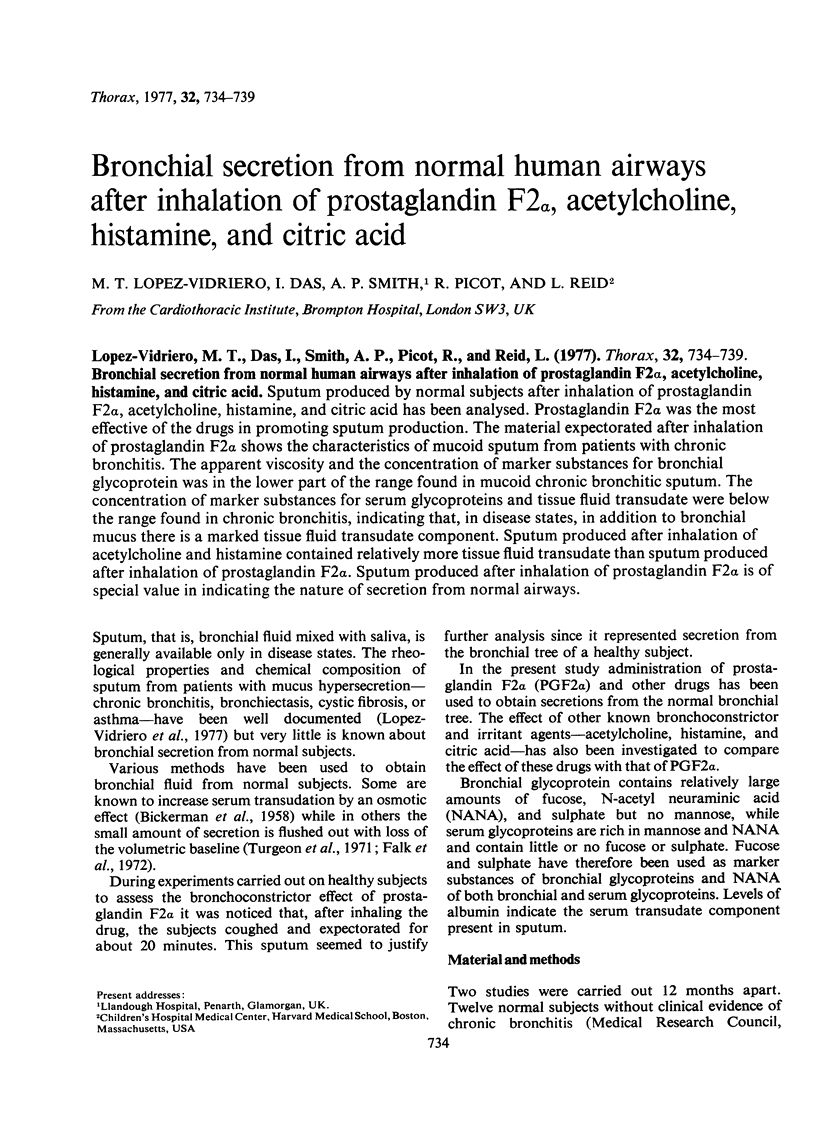
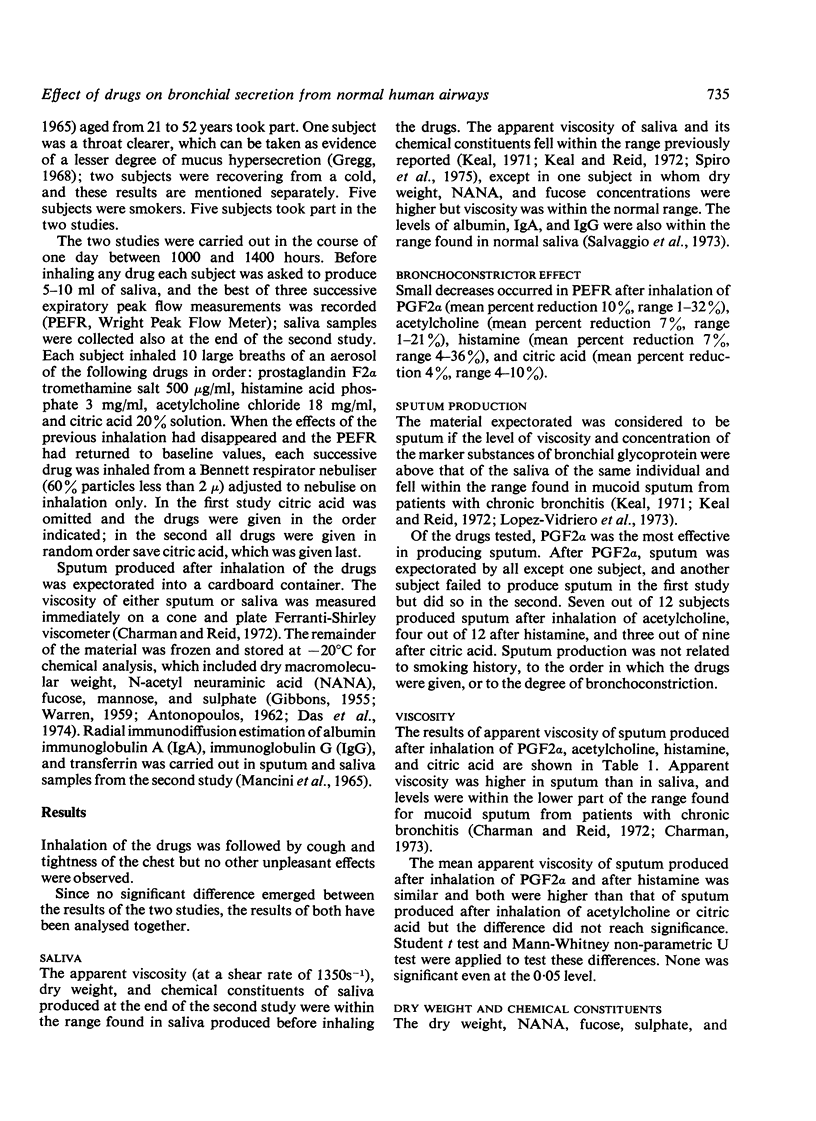
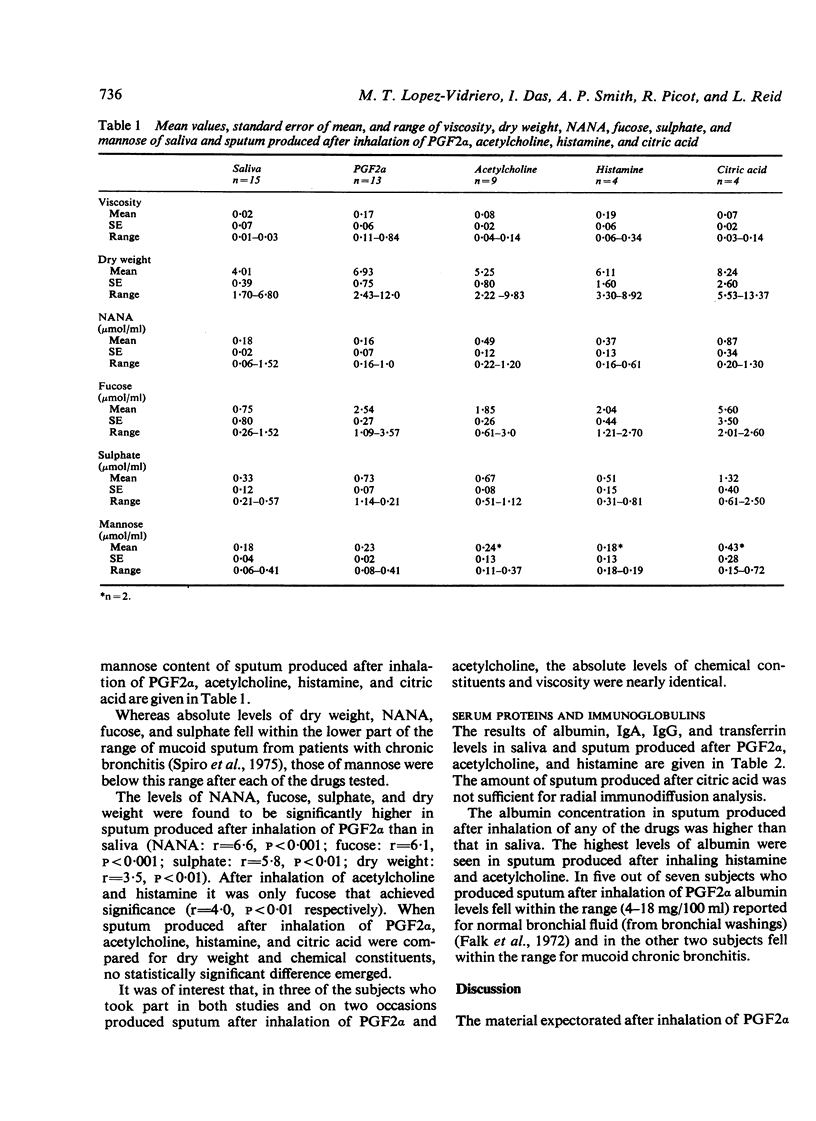
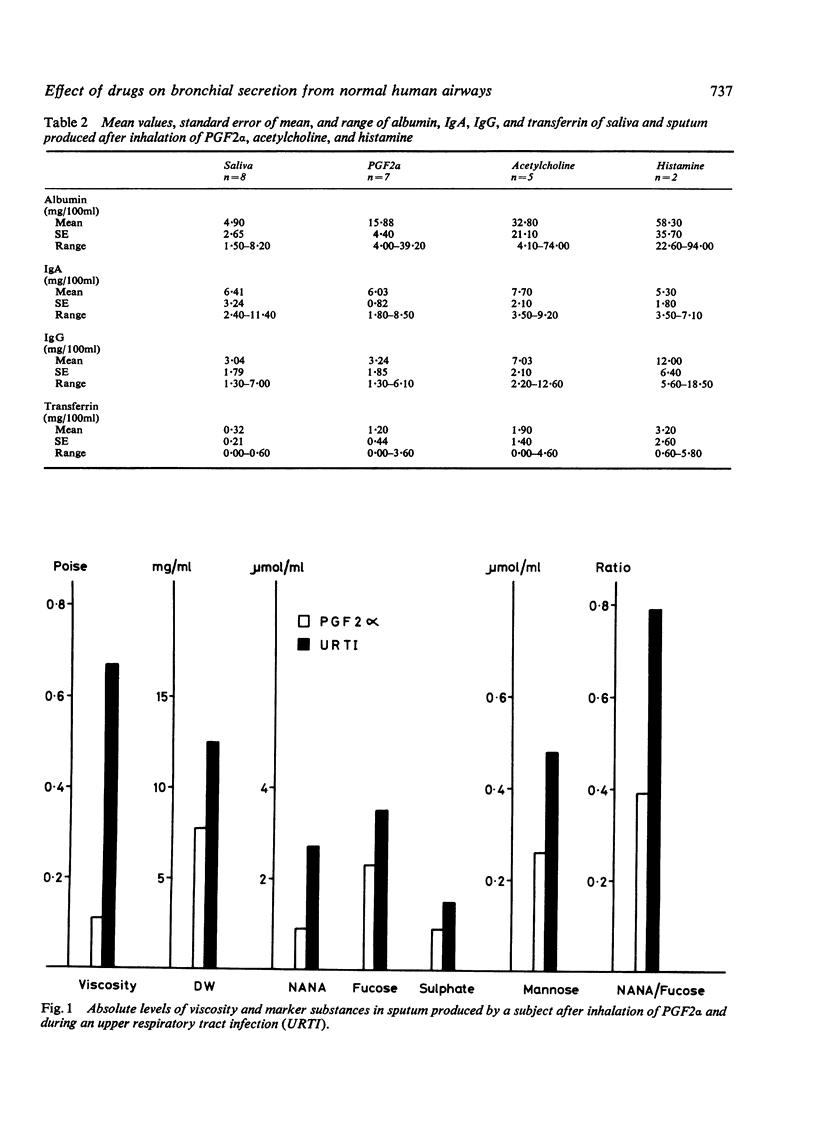
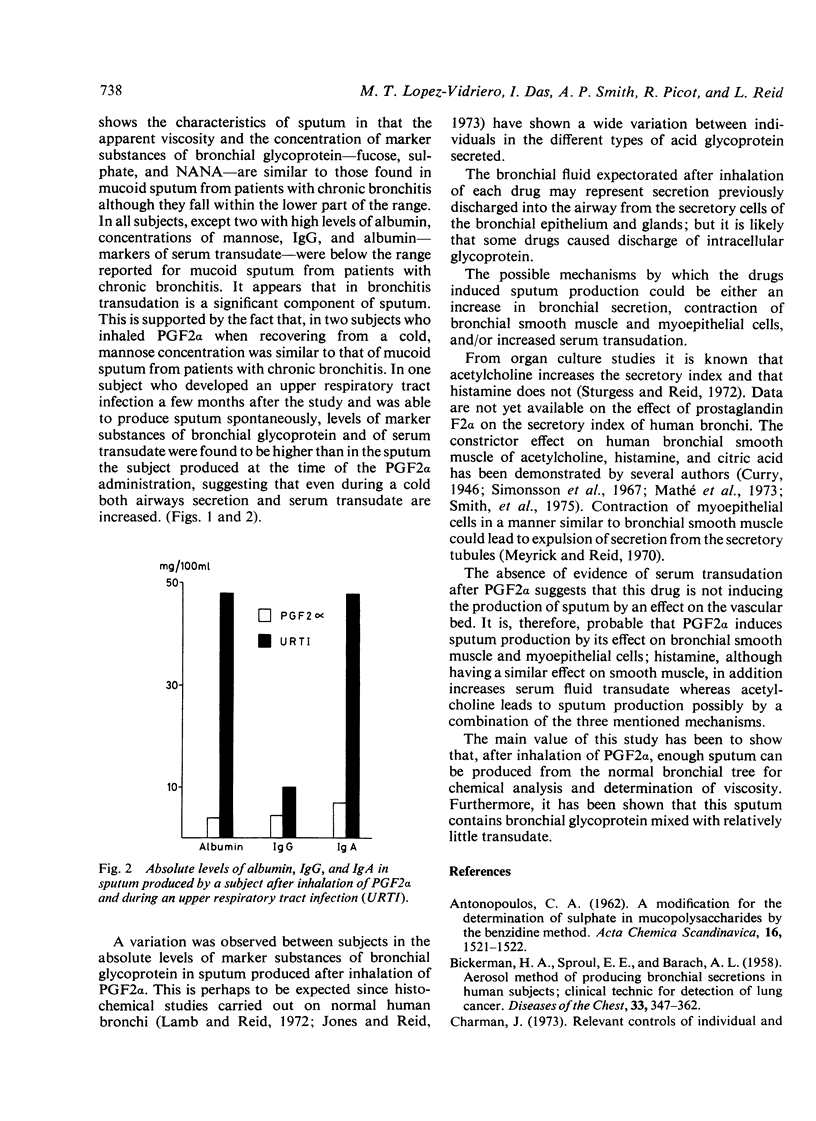
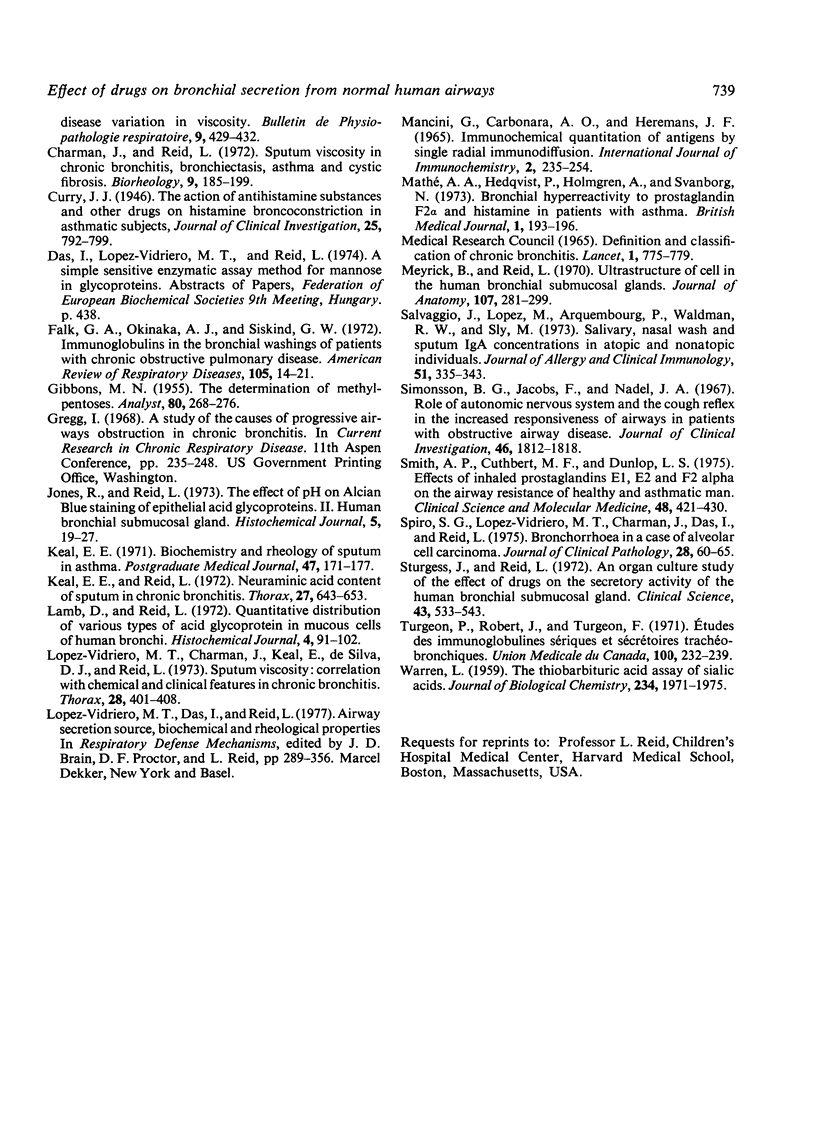
Selected References
These references are in PubMed. This may not be the complete list of references from this article.
- BICKERMAN H. A., SPROUL E. E., BARACH A. L. An aerosol method of producing bronchial secretions in human subjects: a clinical technic for the detection of lung cancer. Dis Chest. 1958 Apr;33(4):347–362. doi: 10.1378/chest.33.4.347. [DOI] [PubMed] [Google Scholar]
- Charman J., Reid L. Sputum viscosity in chronic bronchitis, bronchiectasis, asthma and cystic fibrosis. Biorheology. 1972 Sep;9(3):185–199. doi: 10.3233/bir-1972-9310. [DOI] [PubMed] [Google Scholar]
- Curry J. J. THE EFFECT OF ANTIHISTAMINE SUBSTANCES AND OTHER DRUGS ON HISTAMINE BRONCHOCONSTRICTION IN ASTHMATIC SUBJECTS. J Clin Invest. 1946 Nov;25(6):792–799. doi: 10.1172/JCI101765. [DOI] [PMC free article] [PubMed] [Google Scholar]
- Falk G. A., Okinaka A. J., Siskind G. W. Immunoglobulins in the bronchial washings of patients with chronic obstructive pulmonary disease. Am Rev Respir Dis. 1972 Jan;105(1):14–21. doi: 10.1164/arrd.1972.105.1.14. [DOI] [PubMed] [Google Scholar]
- Gregg I. A study of the causes of progressive airways obstruction in chronic bronchitis. Aspen Emphysema Conf. 1968;11:235–248. [PubMed] [Google Scholar]
- Jones R., Reid L. The effect of pH on Alcian Blue staining of epithelial acid glycoproteins. II. Human bronchial submucosal gland. Histochem J. 1973 Jan;5(1):19–27. doi: 10.1007/BF01012041. [DOI] [PubMed] [Google Scholar]
- Keal E. E. Biochemistry and rheology of sputum in asthma. Postgrad Med J. 1971 Mar;47(545):171–177. doi: 10.1136/pgmj.47.545.171. [DOI] [PMC free article] [PubMed] [Google Scholar]
- Keal E. E., Reid L. Neuraminic acid content of sputum in chronic bronchitis. Thorax. 1972 Nov;27(6):643–653. doi: 10.1136/thx.27.6.643. [DOI] [PMC free article] [PubMed] [Google Scholar]
- Lamb D., Reid L. Quantitative distribution of various types of acid glycoprotein in mucous cells of human bronchi. Histochem J. 1972 Mar;4(2):91–102. doi: 10.1007/BF01004968. [DOI] [PubMed] [Google Scholar]
- Lopez-Vidriero M. T., Charman J., Keal E., De Silva D. J., Reid L. Sputum viscosity: correlation with chemical and clinical features in chronic bronchitis. Thorax. 1973 Jul;28(4):401–408. doi: 10.1136/thx.28.4.401. [DOI] [PMC free article] [PubMed] [Google Scholar]
- Mancini G., Carbonara A. O., Heremans J. F. Immunochemical quantitation of antigens by single radial immunodiffusion. Immunochemistry. 1965 Sep;2(3):235–254. doi: 10.1016/0019-2791(65)90004-2. [DOI] [PubMed] [Google Scholar]
- Mathé A. A., Hedqvist P., Holmgren A., Svanborg N. Bronchial hyperreactivity to prostaglandin F 2 and histamine in patients with asthma. Br Med J. 1973 Jan 27;1(5847):193–196. doi: 10.1136/bmj.1.5847.193. [DOI] [PMC free article] [PubMed] [Google Scholar]
- Meyrick B., Reid L. Ultrastructure of cells in the human bronchial submucosal glands. J Anat. 1970 Sep;107(Pt 2):281–299. [PMC free article] [PubMed] [Google Scholar]
- Salvaggio J., Lopez M., Arquembourg P., Waldman R., Sly M. Salivary, nasal wash, and sputum IgA concentrations in atopic and nonatopic individuals. J Allergy Clin Immunol. 1973 Jun;51(6):335–343. doi: 10.1016/0091-6749(73)90072-9. [DOI] [PubMed] [Google Scholar]
- Simonsson B. G., Jacobs F. M., Nadel J. A. Role of autonomic nervous system and the cough reflex in the increased responsiveness of airways in patients with obstructive airway disease. J Clin Invest. 1967 Nov;46(11):1812–1818. doi: 10.1172/JCI105671. [DOI] [PMC free article] [PubMed] [Google Scholar]
- Smith A. P., Cuthbert M. F., Dunlop L. S. Effects of inhaled prostaglandins E1, E2, and F2alpha on the airway resistance of healthy and asthmatic man. Clin Sci Mol Med. 1975 May;48(5):421–430. doi: 10.1042/cs0480421. [DOI] [PubMed] [Google Scholar]
- Spiro S. G., Lopez-Vidriero M-T, Charman J., Das I., Reid L. Bronchorrhoea in a case of alveolar cell carcinoma. J Clin Pathol. 1975 Jan;28(1):60–65. doi: 10.1136/jcp.28.1.60. [DOI] [PMC free article] [PubMed] [Google Scholar]
- Sturgess J., Reid L. An organ culture study of the effect of drugs on the secretory activity of the human bronchial submucosal gland. Clin Sci. 1972 Oct;43(4):533–543. doi: 10.1042/cs0430533. [DOI] [PubMed] [Google Scholar]
- Turgeon P., Robert J., Turgeon F. Etude des immunoglobulines sériques et sécrétoires trachéo-bronchiques. Union Med Can. 1971 Feb;100(2):232–239. [PubMed] [Google Scholar]
- WARREN L. The thiobarbituric acid assay of sialic acids. J Biol Chem. 1959 Aug;234(8):1971–1975. [PubMed] [Google Scholar]


